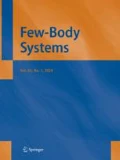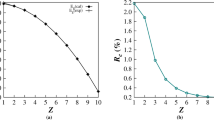Abstract
Ground state energies of atomic three-body systems like negatively charged hydrogen, normal helium, positively charged-lithium, beryllium, carbon, oxygen, neon and negatively charged exotic- muonium and positronium atoms have been calculated adopting hyperspherical harmonics expansion method. Calculation of matrix elements of two body interactions needed in the hyperspherical harmonics expansion method for a three body system is greatly simplified by expanding the bra- and ket-vector states in the hyperspherical harmonics (HH) basis states appropriate for the partition corresponding to the interacting pair. This involves the Raynal–Revai coefficients (RRC), which are the transformation coefficients between the HH bases corresponding to the two partitions. Use of RRC become particularly essential for the numerical solution of three-body Schrődinger equation where the two-body potentials are other than Coulomb or harmonic. However in the present work the technique is used for two electron atoms 1H−(p + e − e −), D−(d + e − e −), Mu−(μ + e − e −),4He(4 He 2+ e − e −),6Li(6 Li 3+ e − e −),10Be(10 Be 4+ e − e −),12C(12 C 6+ e − e −),16O(16 O 8+ e − e −) etc. and the exotic positronium negative ion Ps −(e + e − e −) where the interactions are purely Coulomb. The relative convergence in ground state binding energy with increasing K max for 20Ne has been demonstrated as a representative case. The calculated energies at K max = 28 using RRC’s have been compared with those obtained by a straight forward manner in some representative cases to demonstrate the appropriateness of the use of RRC. The extrapolated energies have also been compared with those found in the literature. The calculated binding energies agree within the computational error.
Similar content being viewed by others
References
Ancarani, L.U., Rodriguez, K.V., Gasaneo, G.: Ground and excited states for exotic three-body atomic systems. In: EPJ Web of Conferences 3, 02009 (2010); Correlated 1,3 S States for Coulomb Three-Body Systems. Int. J. Quantum Chem. 00, 0 (2011)00 (and references therein)
Sultanov R.A., Dennis G.: Integraldifferential equations approach to atomic three-body systems. J. Comput. Phys. 192(1), 231 (2003)
Chen Z., Lin C.D.: Classification of Coulomb three-body systems in hyperspherical co-ordinates. Phys. Rev. A42(1), 18 (1990)
Yalcin Z., Simsek M.: Potential harmonic approximation in atomic three-body systems with Fues–Kratzer-type potential. Int. J. Quantum Chem. 88(6), 735 (2002)
Kleindienst L., Emrich R.: The atomic three-body problem. An accurate lower bond calculation using wave functions with logarithmic terms. Int. J. Quantum Chem. 37(3), 257 (1990)
Baklanov E.V.: Ground state of negative positronium ion within the framework of the non-relativistic three-body problem. Laser Phys. 7(4), 970 (1997)
Dodd L.R.: Faddeev approach to atomic three-body problems. Phys. Rev. A9(4), 637 (1974)
Harris, F.E.: Current Studies of Few Electron Systems. In: Lecture Series on Computer and Computational Sciences, vol. 1, p. 1 (2006)
Krivec R., Mandelzweig V.B.: Matrix elements of potentials in the correlation function hyperspherical harmonic method. Phys. Rev. A42, 3779 (1990)
Haftel H.I., Mandelzweig V.B.: A fast convergent hyperspherical expansion for the helium ground state. Phys. Lett. A120(5), 232 (1987)
Haftel H.I., Mandelzweig V.B.: Exact solution of coupled equations and the hyperspherical formalism: calculation of expectation values and wavefunctions of three Coulomb-bound particles. Ann. Phys. 150(1), 48 (1983)
Rodriguez K.V., Ancarani L.U., Gasaneo G., Mitnik D.M.: Ground state for two-electron and electron-muon three-body atomic systems. Int. J. Quantum Chem. 110(10), 1820 (2010)
Smith V.H. Jr, Frolov A.M.: On properties of the helium-muonic and helium-antiprotonic atoms. J. Phys. B28(7), 1357 (1995)
Frolov A.M., Smith V.H. Jr: Bound state properties and astrophysical applications of negatively charged hydrogen ions. J. Chem. Phys. 119, 3130 (2003)
Frolov A.M., Yeremin A., Yu J.: Ground bound states in two-electron systems with Z = 1. J. Phys. B22, 1263 (1989)
Thakkar A.J., Koga T.: Ground-state energies for the helium isoelectronic series. Phys. Rev. A50, 854 (1994)
Frolov A.M., Smith V.H. Jr: Universal variational expansion for three-body systems. J. Phys. B28, L449 (1995)
Goldman S.P.: Uncoupling Correlated Calculations in atomic physics: very high accuracy and ease. Phys. Rev. A57, R677 (1998)
Frolov A.M.: Bound state properties of negatively charged hydrogen like ions. Phys. Rev. A58, 4479 (1998)
Frolov A.M.: Properties and hyperfine structure of helium-muonic atoms. Phys. Rev. A61, 022509 (2000)
Frolov A.M.: Calculations of the 1s μ 2s e -electron-excited S(L = 0) states in helium-muonic atoms. Phys. Rev. A65, 024701 (2002)
Frolov A.M.: Lowest order QED corrections for the H− and Mu− ions. Phys. Lett. A345, 173 (2005)
Frolov A.M.: Bound state properties and hyperfine splitting in the S(L = 0)-states of the lithium-muonic systems. Phys. Lett. A353, 60 (2006)
Frolov A.M., Smith V.H. Jr: Exponential representation in the Coulomb three-body problem. J. Phys. B37, 2917 (2004)
Korobov R.: Bethe logarithm for the helium atom. Phys. Rev. A69, 054501 (2004)
Drake, G.W.F.: Units and constants. In: Springer Handbook of Atomic, Molecular, and Optical Physics, p. 1. Springer, Berlin (2005)
Hylleraas E.A., Ore A.: Electron affinity of positronium. Phys. Rev. 71, 491 (1947)
Hill R.N.: Proof that the H− ion has only one bound state. Details and extension to finite nuclear mass. J. Math. Phys. 18, 2316 (1977)
Mohr Peter J., Taylor Barry N.: The fundamental physical constants—recommended values of the basic constants and conversion values, from the 1998 adjustment. Phys. Today 55(8), BG6 (2002)
Drake G.W.F., Cassar Mark M., Nistor R.A.: Ground-state energies for helium, H−, and Ps−. Phys. Rev. A65, 054501 (2002)
Frolov A.M.: Variational expansions for the three-body coulomb problem. Zh. Eksp. Teor. Fiz 92, 1959 (1987)
Mills A.P. Jr.: Observation of the Positronium Negative Ion. Phys. Rev. Lett. 46, 717 (1981)
Mills A.P. Jr.: Measurement of the decay rate of the positronium negative ion. Phys. Rev. Lett. 50, 671 (1983)
Ho Y.K.: Autoionization states of the positronium negative ion. Phys. Rev. A 19, 2347 (1979)
Ho Y.K.: Variational calculation of ground-state energy of positronium negative ions. Phys. Rev. A48, 4780 (1993)
Wen-Fang X.I.E.: Feature of a confined positronium negative ion by a spherical parabolic potential. Commun. Theor. Phys. (Beijing, China) 47, 547 (2007)
Khan Md.A., Dutta S.K., Das T.K.: Computation of Raynal–Revai coefficients for the hyperspherical approach to a three-body system. FIZIKA B (Zagreb) 8(4), 469 (1999)
Lin C.D.: Hyperspherical coordinate approach to atomic and Coulombic three-body systems. Phys. Rept. 257, 1 (1995)
Das T.K., Chattopadhyay R., Mukherjee P.K.: Hyperspherical harmonics approach to the ground and excited states of two electron atoms. Phys. Rev. A50, 3521 (1994)
Chattopadhyay R., Das T.K., Mukherjee P.K.: Hyperspherical harmonics expansion of the ground state of the Ps− ion. Phys. Scripta 54, 601 (1996)
Chattopadhyay R., Das T.K.: Adiabatic approximation in atomic three body systems. Phys. Rev. A56, 1281 (1997)
Das T.K., Coelho H.T., Fabredela Ripelle M.: Contribution of three body force to the trinucleon problem by an essentially exact calculation. Phys. Rev. C26, 2288 (1982)
Coelho H.T., Das T.K., Fabredela Ripelle M.: Effect of two pion exchange three nucleon forces on trinucleon systems. Phys. Lett. 109B, 255 (1982)
Das T.K., Coelho H.T.: Trinucleon Coulomb energy with inclusion of three body force. Phys. Rev. (Rapid comm) C26, 754 (1982)
Das T.K., Coelho H.T.: Dependence of trinucleon observables on three body force. Phys. Rev. C26, 697 (1982)
Coelho H.T., Das T.K., Robilotta M.: Two pion exchange three nucleon force and the 3H and 3He nuclei. Phys. Rev. C28, 1812 (1983)
De T.B., Das T.K.: Calculation of geometrical structure coefficients for the trinucleon system with central and tensor interactions. Phys. Rev. C 36, 402 (1987)
Brito V.P., Coelho H.T., Das T.K.: Adiabatic approximation in few body molecular and nuclear systems. Phys. Rev. A40, 3346 (1989)
Ghosh A.K., Das T.K.: Triton asymptotic normalization constants by the hyperspherical harmonics expansion method. Phys. Rev. C42, 1249 (1990)
Das T.K., Coelho H.T., Torreao J.R.A.: Hyperspherical harmonics approach for the trinucleon system with hard core potential. Phys. Rev. C45, 2640 (1992)
Bhattacharya S., Das T.K., Kanta K.P., Ghosh A.K.: Convergence of triton asymptotic wave function for hyperspherical harmonics expansion with two nucleon Reid soft core potential. Phys. Rev. C50, 2228 (1994)
Yakhelef A., Timofeyuk N.K., Al-Khalili J.S., Thompson I.J.: Few-Body Syst. 47, 213 (2010)
Khan Md.A., Dutta S.K., Das T.K., Pal M.K.: Hyperspherical three-body calculation for neutron drip line nuclei. J. Phys. G: Nucl. Part. Phys. 24, 1519 (1998)
Khan Md.A., Das T.K., Chakrabarti B.: Study of the excited state of double-Λ hypernuclei by hyperspherical supersymmetric approach. Int. J. Mod. Phys. E10(2), 107 (2001)
Khan Md.A., Das T.K.: Study of ΛΛ dynamics and ground state structure of low and medium mass double Λ hypernuclei. Pramana J. Phys. 56(1), 57 (2001)
Khan Md.A., Das T.K.: Investigation of halo structure of 6He by hyperspherical three-body method. Pramana J. Phys. 57(4), 701 (2001)
Dutta S.K., Khan Md.A., Das T.K., Chakrabarti B.: Calculation of resonances in weakly bound systems. Int. J. Mod. Phys. E13(4), 811 (2004)
Dutta S.K., Das T.K., Khan Md.A., Chakrabarti B.: Resonances in A = 6 nuclei: use of supersymmetric quantum mechanics. Few-Body Syst. 35, 33 (2004)
Dutta S.K., Das T.K., Khan Md.A., Chakrabarti B.: Computation of 2+ resonance in 6He: bound state in the continuum. J. Phys. G: Nucl. Part. Phys. 29, 2411 (2003)
Khan Md.A., Das T.K.: Investigation of exotic \({^6_{\Lambda\Lambda}}\) He hypernuclei by the hyperspherical three-body method. FIZIKA B9(2), 55 (2000)
Khan Md.A., Das T.K.: Investigation of ΛΛ dynamics and effective ΛN interaction in low and medium mass hypernuclei. FIZIKA B10(2), 83 (2001)
Richard J.M.: The non-relativistic three-body problem for baryons. Phys. Rep. 212, 1 (1992)
Leeb H., Fiedeldey H., Gavin E.G.O., Sofianos S.A., Lipperheide R.: Quark quark potentials from the inversion of baryon spectra and its application to the Roper resonance. Few-Body Syst. 12, 55 (1992)
Barnea N., Novoselsky A.: Construction of hyperspherical functions symmetrized with respect to the orthogonal and symmetric groups. Ann. Phys. (New York) 256, 192 (1997)
Watanabe S., Hosoda Y., Kato D.: Hyperspherical close-coupling method extended to the two-electron continuum region: test on the s-wave model for e-H scattering. J. Phys. B26, L495 (1993)
Ballot J.L., Fabredela Ripelle M.: Application of the hyperspherical formalism to the trinucleon bound state problems. Ann. Phys. (New York) 127, 62 (1980)
Raynal J., Revai J.: Transformation coefficients in the hyperspherical approach to the three-body problem. Il Nuo. Cim. A68(4), 612 (1970)
Youping G., Fuqing L., Lim T.K.: Program to calculate Raynal–Revai coefficients of a three-body system in two or three dimensions. Comp. Phys. Comm. 47, 149 (1987)
Cohen E.R., Taylor B.N.: CODATA recommended values of the fundamental physical constants. Phys. Today 51, 8–BG9 (1998)
Cohen E.R., Taylor B.N.: CODATA recommended values of the fundamental physical constants. Phys. Today 53, 8–BG11 (2000)
Johnson B.R.: The renormalized Numerov method applied to calculating bound states of the coupled-channel Schroedinger equation. J. Chem. Phys. 69, 4678 (1978)
Author information
Authors and Affiliations
Corresponding author
Rights and permissions
About this article
Cite this article
Khan, M.A. Hyperspherical Three-Body Calculation for Exotic Atoms. Few-Body Syst 52, 53–63 (2012). https://doi.org/10.1007/s00601-011-0264-3
Received:
Accepted:
Published:
Issue Date:
DOI: https://doi.org/10.1007/s00601-011-0264-3




